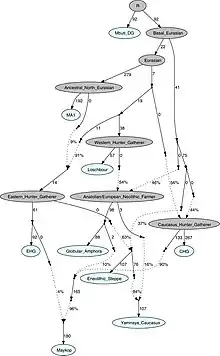Basal Eurasian
Basal-Eurasian is a hypothetical line of descent,[1][2] which exists in greatest amount among ancient Near East individuals.[1] Basal Eurasians may have been present in the Near East, as anatomically modern humans resided in the Levant approximately 100,000 years ago.[2] The areas of the Near East where Basal Eurasians resided may have been areas where contact with Neanderthals, who were known to have lived in West Eurasia, were not made. Consequently, Basal Eurasians likely did not become admixed with Neanderthals.[3]
Basal Eurasians are the sibling group that diverged from the main lineage of all other non-African groups[4] (e.g. European hunter-gatherers (pre-Neolithic), East Asians, Oceanians),[5][6] prior to their divergence from one another.[4] The admixture of the main lineage of all other non-Africans with Neanderthals likely occurred 50,000-60,000 years ago, after they diverged from Basal Eurasians.[1]
The early spread of ancestry from Basal Eurasians spanned from Georgia, dated to 26,000 years ago, to Morocco, dated to 15,000 years ago.[3] Amid the Holocene, the spread of ancestry from Basal Eurasians expanded more broadly into the regions of South Asia and West Eurasia.[3]

The scenario of a non-Neanderthal-admixed modern human population, which is basal to other Eurasians, and resided in Africa, is plausible.[1] In particular, North Africa and Western Asia are strong candidates as a location for the emergence of Basal-Eurasians as it shares notable connection with Eurasia.[7] The early Levantine Natufian people shared craniometric affinity with North Africans and in some respects with Sub-Saharan Africans. However, according to Lazaridis et al., Natufians did not share a greater amount of alleles with Sub-Saharan Africans than other ancient Eurasians, and the Basal Eurasian ancestry in Natufians is consistent with originating from the same population as Neolithic Iranians and Mesolithic Iranians.[1] Mesolithic Iranians (66±13%), Neolithic Iranians (48±6%), and Epipaleolithic Natufians (44±8% or 63%[8]) share Basal-Eurasian ancestry.[5] Another estimate given for Holocene-era Near Easterners (e.g., Mesolithic Caucasian Hunter Gatherers, Mesolithic Iranians, Neolithic Iranians, Natufians) is that they possess up to 50% Basal Eurasian ancestry.[7] Additionally, while the Taforalt individuals were considered likely direct descendants of Basal Eurasians, they were shown to not be genetically closer to Basal Eurasians than Holocene-era Iranians.[7]
Early European Farmers (EEFs), who had some Western European Hunter-Gatherer-related ancestry and originated in the Near East, also derive approximately 44% of their ancestry from Basal Eurasians.[2]
References
- Lazaridis, I (2016). "Genomic insights into the origin of farming in the ancient Near East" (PDF). Nature. 536 (7617): 419–424. Bibcode:2016Natur.536..419L. doi:10.1038/nature19310. PMC 5003663. PMID 27459054.
- Lazaridis, Iosif (2014). "Ancient human genomes suggest three ancestral populations for present-day Europeans". Nature. 513 (7518): 409–413. arXiv:1312.6639. Bibcode:2014Natur.513..409L. doi:10.1038/nature13673. PMC 4170574. PMID 25230663.
- Bergström, Anders; et al. "Origins of modern human ancestry" (PDF). Nature.
- Lazaridis, Iosif (2018). "The evolutionary history of human populations in Europe". Current Opinion in Genetics & Development. 53: 21–27. arXiv:1805.01579. doi:10.1016/j.gde.2018.06.007. PMID 29960127.
- Lazaridis, Iosif (2016). "Genomic insights into the origin of farming in the ancient Near East". Nature. 536 (7617): 419–424. Bibcode:2016Natur.536..419L. doi:10.1038/nature19310. PMC 5003663. PMID 27459054.
- Fu, Qiaomei (2016). "The genetic history of Ice Age Europe". Nature. 534 (7606): 200–205. Bibcode:2016Natur.534..200F. doi:10.1038/nature17993. hdl:10211.3/198594. PMC 4943878. PMID 27135931.
- Van de Loosdrecht, Marieke. "Supplementary Materials for Pleistocene North African genomes link Near Eastern and sub-Saharan African human populations" (PDF). Science. Science.
- Reviewer, Anonymous (2018). "Pleistocene North African genomes link Near Eastern and sub-Saharan African human populations". Science. 360 (6388): 548–552. Bibcode:2018Sci...360..548V. doi:10.1126/science.aar8380. PMID 29545507.